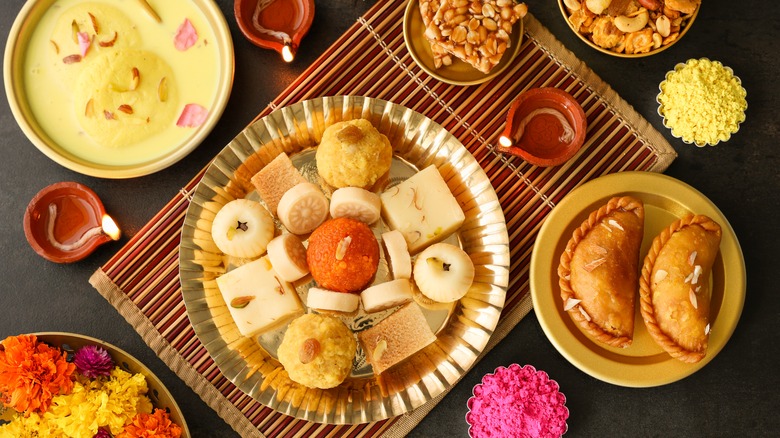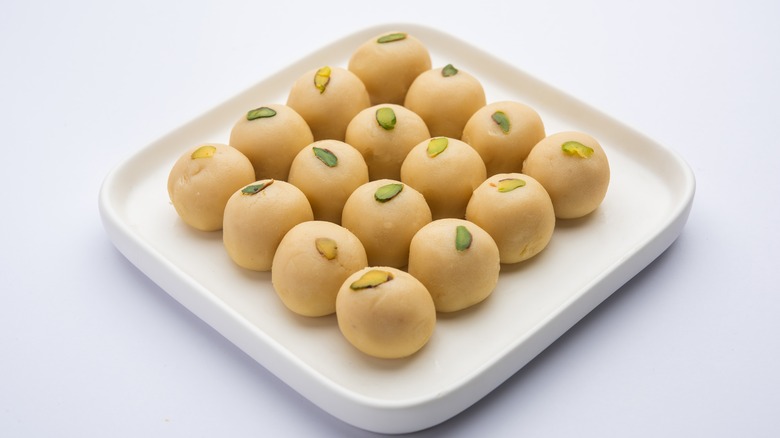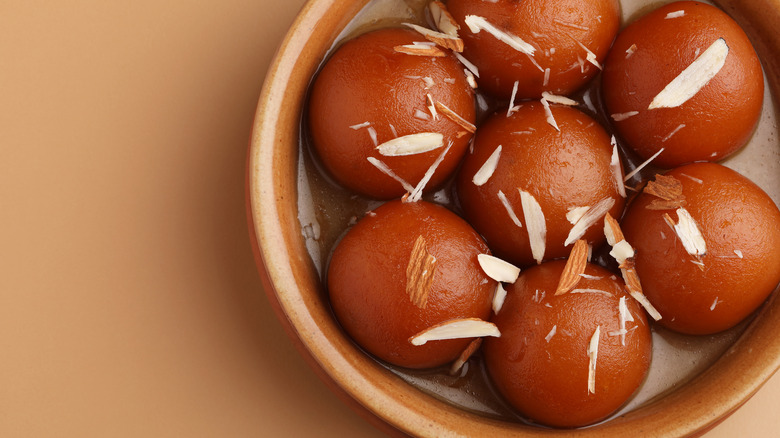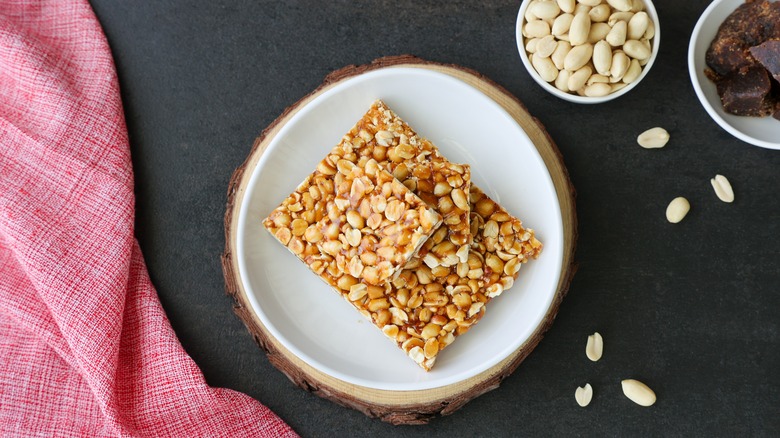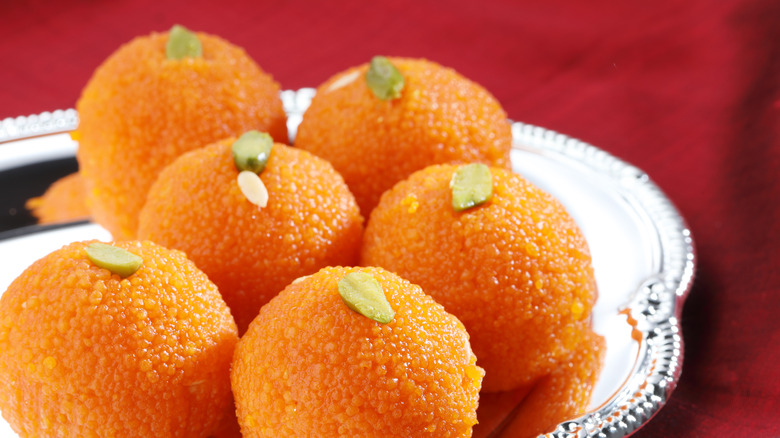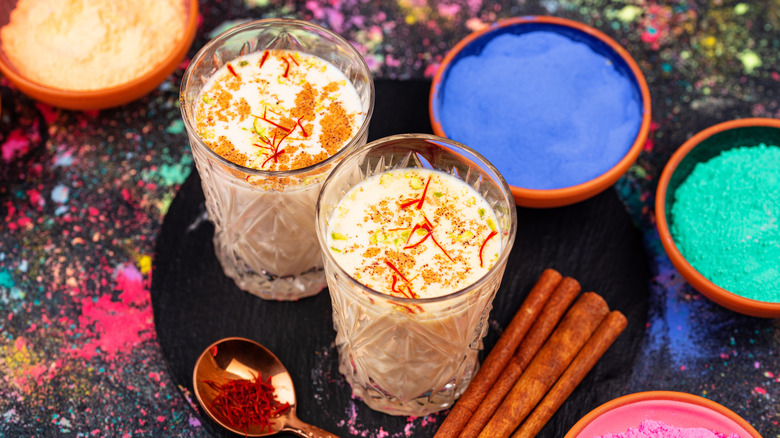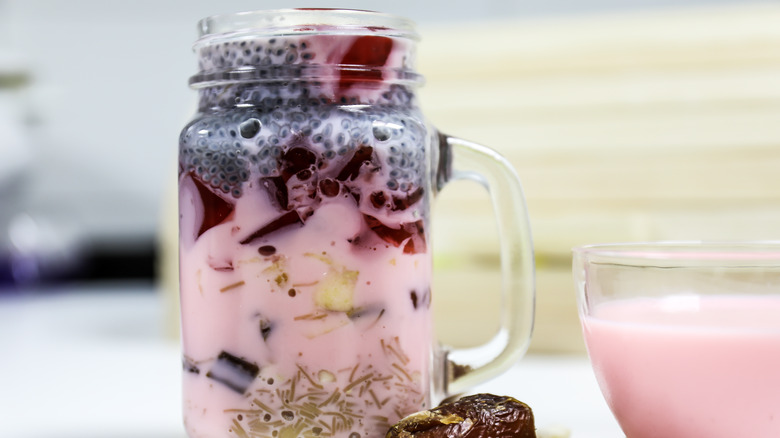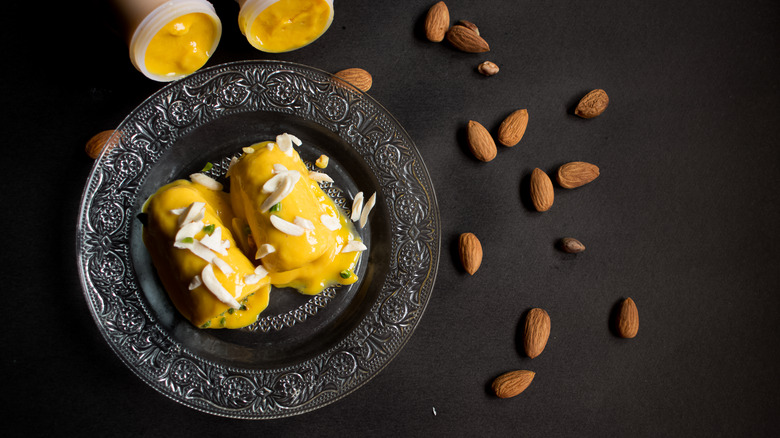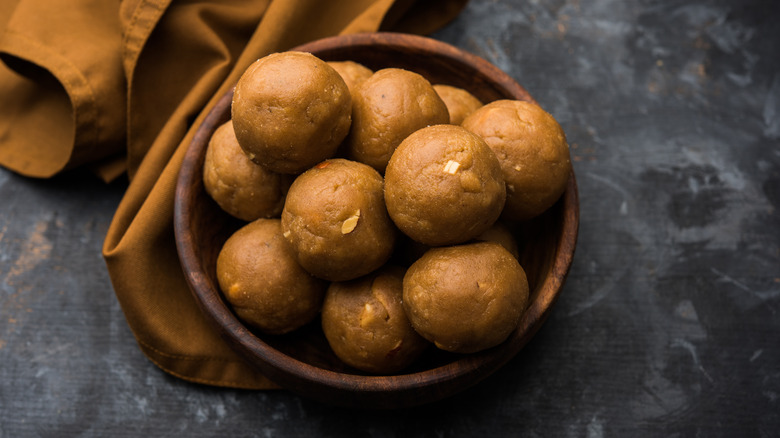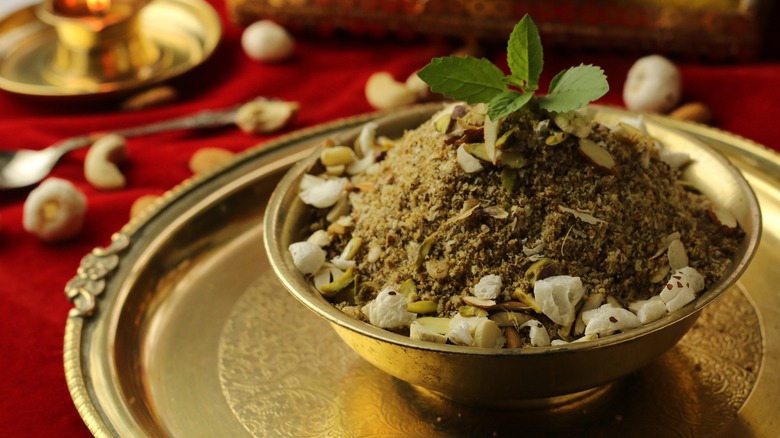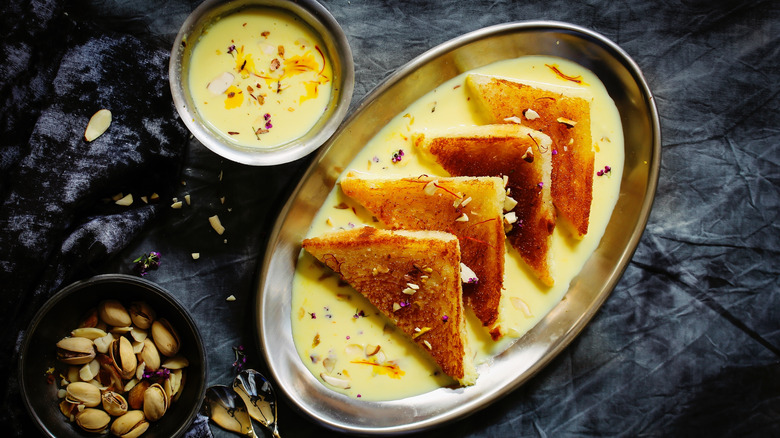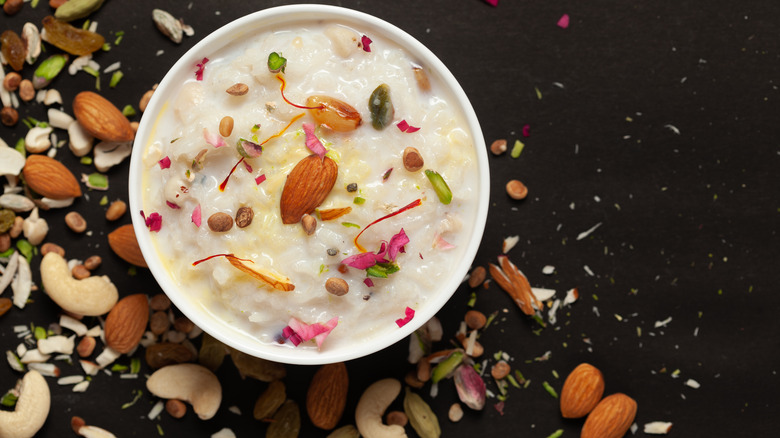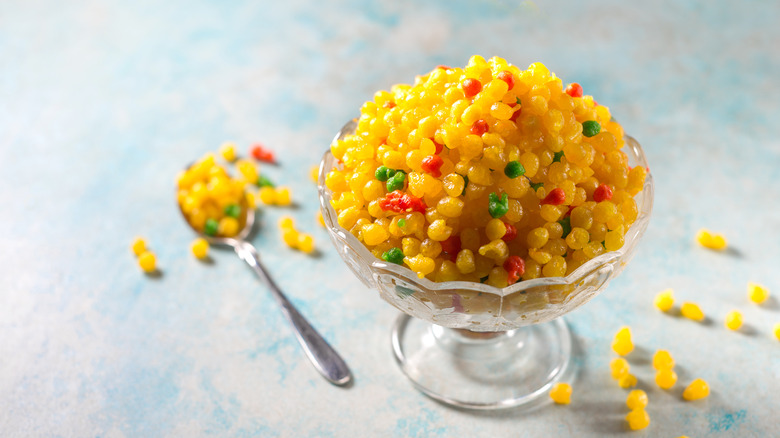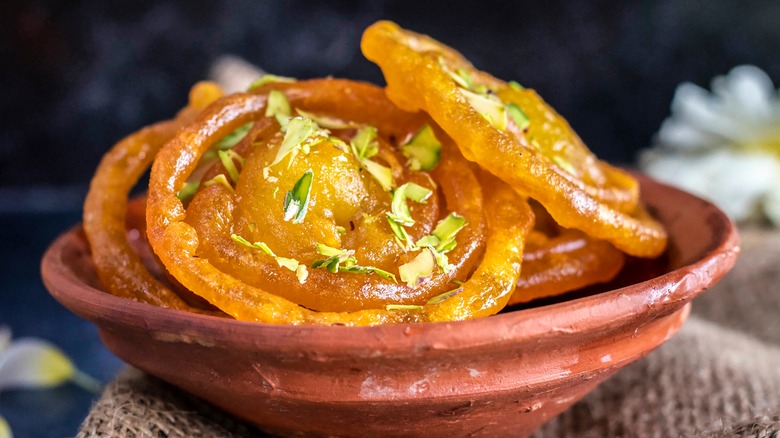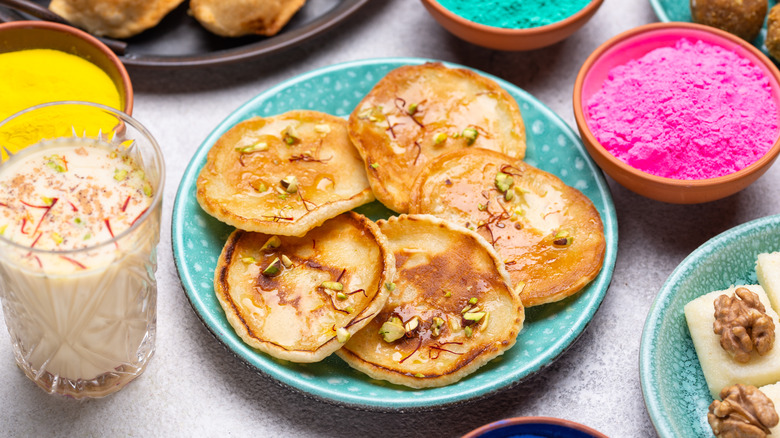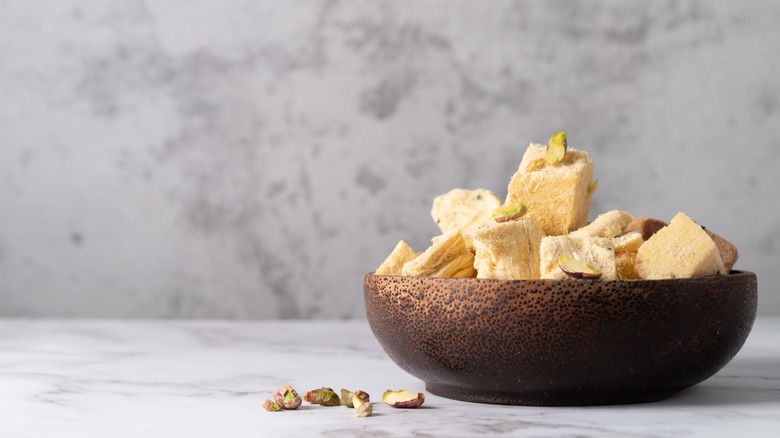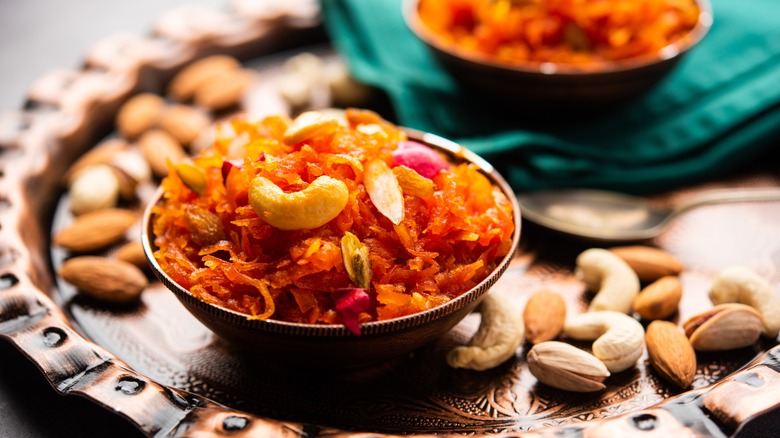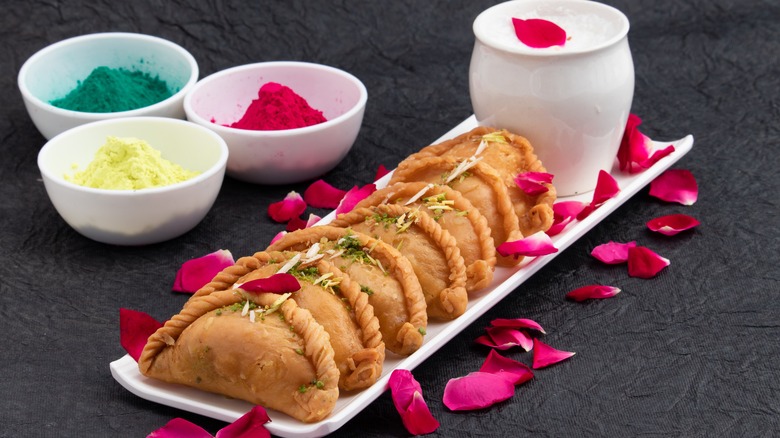17 Must-Try North Indian Mithai
Northern India, consisting of the states Haryana, Himachal Pradesh, Jammu and Kashmir, Punjab, Rajasthan, and sometimes Uttar Pradesh, has historically been an invaluable crossroads for global trade. In the 11th century, Persian traders found their way to India, and a couple of centuries later, in the 16th century, the Mongolian empire spread south as well. With them, the Mongolians and Persians brought many spices, recipes, and foods that still influence Indian cuisine today. With a varying landscape that goes from the great Indo-Gangetic Plains to the striking Himalayas, northern India is home to deep history, culture, and of course, a vast array of sweets, also known as mithai. (via Encyclopedia)
Some of the mithai from northern India are unique to their particular region and state, while others can be found across the country in different variations. Also, northern Indian mithai are heavily influenced by eastern and western Indian sweets. Therefore, you will see a similar technique between the mithai but with ingredients that are more suitable for the cooler, northern climate. With mouth-watering flavors and irresistible textures, there is undoubtedly a dessert for everyone on this enticing, must-try list of northern Indian mithai.
Peda
Peda, an irresistible Indian mithai with a texture similar to fudge, is made from mawa (milk solids), powdered sugar, cardamom, saffron, and nuts. This dessert originates from the sacred city of Mathura in Uttar Pradesh. Mathura is known as the birthplace of Lord Shri Krishna, and during many festivals and holidays, peda is offered as Prasad, a Hindu offering (via Swasthi's Recipies).
Peda comes in many variations, with the most common being doodh peda. Doodh means milk in Hindi, so these peda are made with milk or mawa. Peda can also be made from besan flour, chocolate, nuts, and different kinds of sugar. While doodh peda originates from the north, there are regional types of peda all throughout India, such as palakova in the south, which are often made with buffalo milk.
Gulab jamun
One of the most famous, and beloved desserts across India, gulab jamun are delicious soaked doughnuts that are soft, sweet, fatty, and bursting with flavor and syrup. While not specifically from the north of India, gulab jamun is a beloved dessert that it's a must-try for everyone.
Gulab jamun is usually made from a mawa and flour dough that has been deep-fried. The deep-fried balls are soaked in various syrups such as cardamon, rose water, or saffron. Sometimes sugar is mixed into the dough, which makes a variety known as kala jamun, which is darker in color (via Times Food). You can also make vegan gulab jamun so that every diet can enjoy these delicacies.
Influenced by Persian sweets, gulab jamun today resembles Luqmat-Al-Qadi, a fried dessert popular in the Levant and Gulf countries. In fact, in the Middle East and worldwide, gulab jamun and its variations are very popular and essential for any celebration.
Gajak
Gajak is enjoyed across the world but is very culturally important to a few specific regions in Uttar Pradesh and Punjab, where it is a specialty. Also similar to laiya patti, maroonda, and chikki, gajak is usually made from just two main ingredients, sesame seeds, and jaggery. Gajak can also be made with peanuts, cashews, ghee, or other types of sugar, which contribute to its irresistible crunch. This mithai can come in any shape, but it is usually quite thin, regardless of the size. This enables you to bite into the hard sugar without hurting your teeth. Texturally similar to toffee and brittle, gajak can satisfy any sweet tooth and comes with an additional boost of creaminess from the nuts and seeds (via Times Food).
The festival Makar Sankranti, celebrating the coming of spring, is a time when gajak is widely eaten. The seeds and nuts help keep the body warm in the last chilly days of winter, and the sugar keeps people happy and light.
Motichoor ladoo
Motichoor ladoo is very similar in technique, taste, and look to boondi ladoo. Both of these sweets are made from boondi, small pearls of fried gram flour or chickpea flour. Boondi can be eaten sweet or salty, but when they are made into ladoo or ball desserts, they are always sweetened with syrup. The boondi is mixed with saffron or cardamom and soaked in a sugar syrup until the boondi is soft and able to be rolled into ladoo (via Hebbar's Kitchen).
To make the boondi you need a special, large slotted spoon to drip the batter into the hot oil. This ensures that the boondi will be uniform, small, and crunchy. The difference between motichoor ladoo and boondi ladoo depends on who you ask. Motichoor ladoo is more commonly eaten in the north, while boondi ladoo comes in many variations depending on the region of India you are in. Boondi ladoo can also contain nuts, seeds, and other spices, making it a versatile and delicious mithai (via Dassana's Veg Recipes).
Thandai
Thandai, also known as shardai, is a north Indian drink most commonly consumed during the festival of Holi. Something else to know is that almost whenever there is thandai, there is probably gujiya nearby. These two mithai are commonly paired together, especially during Holi, and the sweetness from the thandai contrasts with the flakey pastry of the gujiya nicely (via Cook With Manali).
Thandai is a cool, refreshing drink made from ground almonds, peppercorns, poppy seeds, cardamom, and sometimes other seeds. According to The Hindu, thandai used to be made from fruit and spices, but today is known as a beloved creamy drink. Thandai is also often made with small amounts of bhang, the leaves, and flower heads of cannabis before being combined with milk and sometimes rose syrup and saffron to add color and floral notes. The thandai is left to chill so that the flavors can infuse into the milk before it is enjoyed.
Falooda
While thandai is the perfect summer drink, falooda is the perfect summer dessert drink. This beloved and world-famous drink is not only special to India but also parts of the Levant and western Asia. In Iran, faloodeh is very similar to Indian falooda in that both desserts have vermicelli noodles swimming in a sweet syrup, usually flavored with rose. Falooda variations are also found in Pakistan, Bangladesh, and Myanmar (via NPR).
In India, falooda comes in many variations, and like other mithai on this list, it is not specifically from the north. Nonetheless, falooda is so irresistible that it belongs on all the lists. North Indian falooda often incorporates kulfi, an ultra-creamy version of ice cream made from milk that has been boiled till it is very thick. This creamy combination, along with the texture of the vermicelli noodles, makes falooda a refreshing and bright dessert.
Kulfi
Kulfi, a frozen custard and ice cream hybrid, is another Indian sweet influenced by the Persians and Mughals. This frozen dessert is made by boiling milk with sugar and cornstarch until it thickens into a smooth custard. This custard can then be flavored with anything, but the crowd favorites are rose, saffron, cardamom, pistachio, vanilla, and mango, according to India.com. The final step is freezing the kulfi, usually in cone-shaped molds, until they are set and fully frozen. However, it is essential that your kulfi freezes slowly and at a low coldness. This gradual freezing prevents ice crystals from forming and ensures that your final kulfi is creamy and smooth.
You can enjoy your refreshing kulfi mixed with falooda or just on a stick like a popsicle. Regardless of how you eat this nationally beloved dessert, kulfi will steal your heart with its creamy, dense, and perfectly sweet flavor.
Aate ki pinni
Aate ki pinni looks like many other ladoo mithai, but do not be deceived; they are unique in their own way. Ladoo is the Hindi word for ball-shaped sweets, while pinni is the Punjabi word. According to Ruchi from Ruchi's Kitchen, aate ki pinni is a traditional mithai from Punjab and is considered a quintessential winter food. Made from whole wheat flour, semolina, nuts, and plenty of ghee, pinni are the perfect winter snack and dessert to give you energy during the cold season.
Pinnis come in many variations across Punjab and India, including additions like cashews, melon seeds, or ground ginger. The ginger is especially great as it brings warmth and a much-welcome immunity boost during the winter.
All across India, in fact, ladoos and pinnis have medicinal roots. Originally created with peanuts, jaggery, and sesame seeds in the 4th century by a physician, ladoos have since transformed all across the country. Today, it is still very common for these ball snacks to be viewed as medicinal, considering that many of the staple ingredients are mentioned in Ayurveda for aiding with blood pressure, digestion, and immunity (via The Better India). Therefore, aate ki pinni are not only a comforting snack but also warming and nutritious for your body, making them the perfect mithai option.
Panjiri
Like aate ki pinni, but served in a more deconstructed way, panjiri is a dry Punjabi mithai that is also eaten chiefly in the winter. As per Times of India, panjiri is made from whole wheat flour, powdered sugar, and ghee. You can also find other variations made with dried nuts, coconut, gond (edible gum), or rava, a type of semolina flour.
Panjiri, especially variations with gond, is a traditional postpartum food and can help the body regain strength and nutrients (via Dassana's Veg Recipes). Even if you did not just give birth, panjiri can be enjoyed by all, especially during the winter, and is delicious served with some warm milk or just eaten by itself. But be careful and don't go too fast. Part of the panjiri experience is savoring the sweet, coarse, crumbly, and dry sensation of this mithai in your mouth.
Shahi tukra
Shahi tukra, also spelled shahi tukda, stems from what is now known as Pakistan but was under the Mughal empire at one point. Shahi, meaning royal, and tukra, meaning piece, is a truly fitting name for this regal dessert. The classic shahi tukra consists of crips pieces of bread that have been doused in rabri, then garnished with nuts. According to DNA India, today, you can find many shahi tukra variations popping up across the country and the world.
Some chefs are playing around which shahi tukra, which DNA India calls "India's eggless bread pudding," by adding in mascarpone or making the rabri into panna cotta. Some chefs also add fruit for some acidity and brightness to help contrast the richness of the rabri and toasted bread. From all of these variations, it is clear that shahi tukra is a very versatile, delicious, and crowd-pleasing dish that is the perfect way to conclude your next meal.
Kheer
Kheer is one of the most beloved and widely available Indian desserts that you can find, and something that makes it so quintessential is its simplicity. At its base, kheer consists of milk and some thickener, whether bits of broken wheat, tapioca, vermicelli noodles, or millet. It is then flavored with saffron or cardamom and topped with pistachios, cashews, and almonds, which bring texture and decoration (via Make Heritage Fun).
Incredibly similar to other milk-based desserts across India, such as payasam from Kerla and firni or phirni from the north, kheer, and all of its variations, are thought to be part of the ancient Indian diet. Kheer is even mentioned in Ayurveda and has strong religious, regional, and cultural significance across India. If you are a milk lover, kheer is the right dessert for you. Adaptable to many tastes and flavored with jaggery's irresistible nuttiness, kheer pairs perfectly with many dishes and meals.
Meethi boondi
Traditional boondi are fried bits of chickpea flour that are used to top many dishes, such as pani puri. These boondi are savory and sometimes slightly spicy, but another version that is incredibly popular is sweet boondi. Similar to boondi ladoo, sweet boondi, or meethi boondi are boondi that have been soaked in sugar syrup to transform this once savory snack into a dessert.
Meethi boondi, according to The Flavours of Kitchen, must be made using a special ladle that has perforated holes so that the perfect-sized drops of besan, or chickpea flour, the batter can drip through. These drips drop right into hot oil or ghee and are fried. To make meethi boondi, you must then soak the boondi in sugar syrup until they are soft and sweet. The boondi is now delicious, but they are even more delightfully tasty when paired with sev for a sweet, savory, crunchy, soft combination.
Jalebi
Jalebis are deeply beloved across India, especially in north India, so it should come as no surprise that this dessert has been an integral Indian mithai for centuries. Jalebi consists of batter fried in hot oil or ghee and then soaked in sugar syrup. They are distinguishable by their distinct, shiny coils and light orange color from saffron.
Jalebi's origins can be traced back to the 10th century when zulbiya, also spelled zulbia, or zoolbia, the Persian sister of jalebi, was created. Zulbiya was brought to India by Persian traders and was quickly adopted into the cuisine. Today, zulbiya remains very popular in modern-day Iran and is an important dessert for Nowruz, the Iranian new year (via The Better India).
While zulbiya and jalebi maintain similarities, jalebi has also transformed regionally across India. In the south, west, and east, many jalebi look-alikes go by the names of jilebi, jilapi, imarti, or jhangiri jalebi, to name a few.
Malupa
This special mithai, usually only consumed during festivals such as Holi and Janmashtami, is a delightful combination of crispy, chewy, and soft. Made of small pancakes that have been deep-fried and then dipped in sugar, malupa are just as decadent as they sound.
Historically, malupas, originally known as apupa, were made from barley flour which is notoriously dense and nutty. The dough was then shaped into a pancake and fried. While today the ingredients have changed, the method of preparation has stayed the same, with some variations popping up over the years. It is possible to find malupas stuffed with various fillings like jaggery or made with other additions like mawa and egg. Regardless of how it is made, malupas are an indulgently sweet and crispy dessert that is best served warm with some fresh cream or rabri (via Harilal's).
Soan papdi
Soan papdi, also known by various other names, is an iconic Indian dessert that appears mostly during Diwali. This mithai, also known as Indian candy floss and very similar to Persian sohan pashmaki and Turkish pismaniye, is made of countless tiny layers that melt in your mouth. Made from milk, gram flour, sugar, and ghee, soan papdi is made by mixing hot sugar syrup into your flour and ghee mixture and combining. This results in the beloved layers that soan papdi is famous for (via India Times).
The origins of soan papdi are not exactly known, but it is widely agreed upon that in India, soan papdi originated either in Maharashtra or Uttar Pradesh. From these regions, it quickly spread north and east. Regardless of its origins, today, soan papdi is a delicious and absolutely essential mithai. With an unbeatable texture, and gentle creaminess and sweetness, this unique dessert will have you begging for more.
Gajar ka halwa
This wonderful Diwali dessert is simple yet incredibly elegant. With only a few ingredients that come together into an irresistible stew, this brightly colored halwa is a brilliant way to use carrots, the main element of gajar ka halwa. To make this Diwali mithai, grated carrots are stewed with milk and spices until it turns into a soft and sweet stew-like dessert.
In India, special carrots are used to make gajar ka halwa. These carrots contain almost no bitterness, making the final gajar ka halwa very sweet and rich. Adding in jaggery makes this dessert even more irresistible because it melts the jaggery into a sweetness that resembles caramel. To spruce up your gajar ka halwa, you can add in nuts, ghee, dried fruit, or seeds. These garnishes pair beautifully with the warm spices of the gajar ka halwa to make it even more comforting and delectable.
Gujiya
This classic north Indian sweet is fairly labor-intensive to make but is worth every minute. Gujiya has fried pockets filled with mawa, milk solids, and nuts. They are very decadent and rich, pairing beautifully with thandai or tea, and are the perfect autumn and winter snack to warm you up on a cold day (via Dassana's Veg Recipes).
Essential in northern India for Holi and Diwali, gujiya closely resemble karanji, a mithai from Maharashtra. However, utlike gujiya, karanji are often filled with poppy seeds and coconut. However, as with many mithai, there are regional variations across the country, and most families will have their unique recipe. Therefore, no matter the type of gujiya you find, we recommend that you give it a try. The sweet, crunchy, and creamy inside with the crisp, flakey pastry is the perfect combination for any mithai, making it a must-try.
